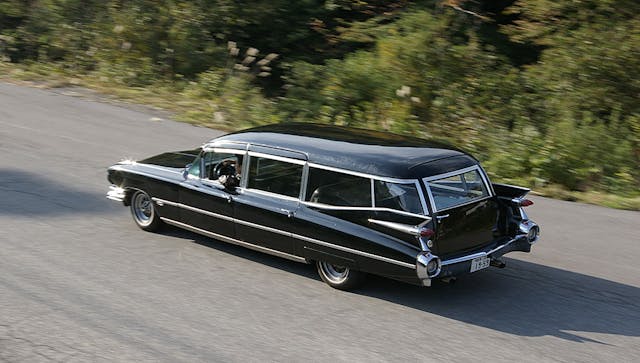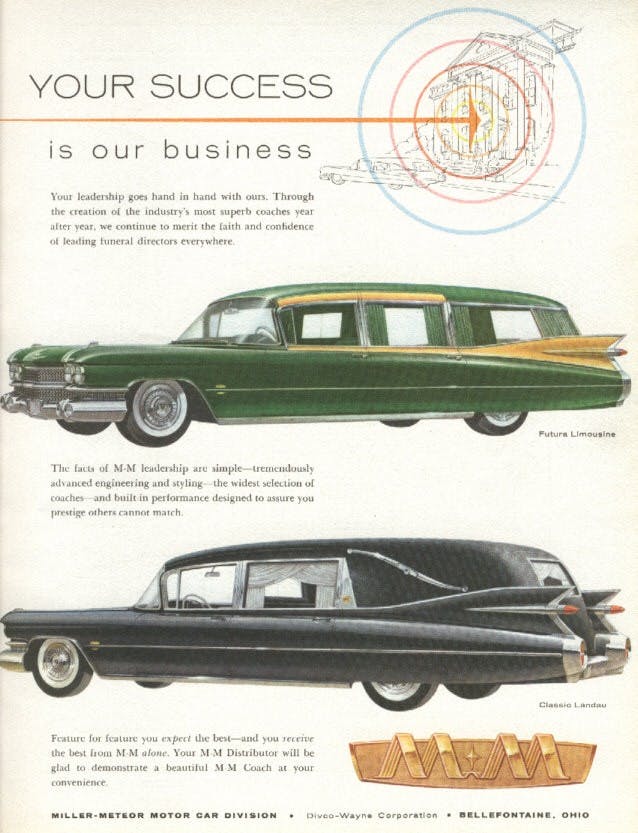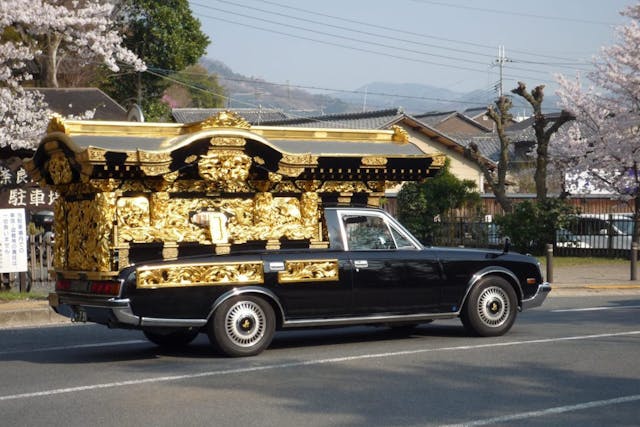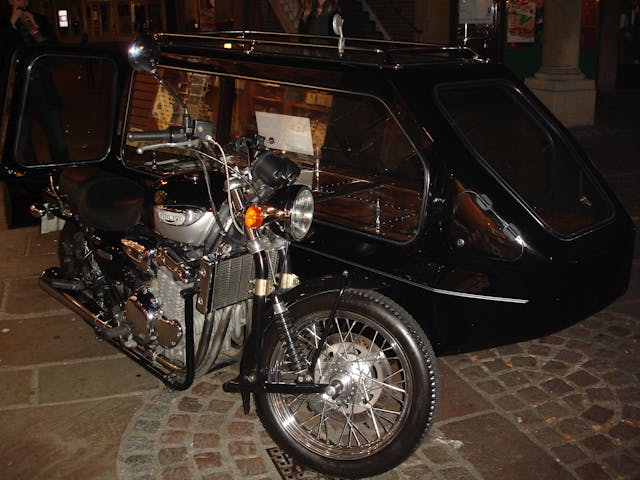Media | Articles
5 strange tales from the realm of the automotive hearse
Every car enthusiast takes one final ride. Unless you have left instructions to be cremated and thrown out of the window while hurtling across the Bonneville Salt Flats (probably not legal), or to be immolated in a Viking funeral pyre at the wheel of your tribute Bullitt Mustang (c’mon man, leave the car to someone else who’ll love it), that means a last drive to the grave in a hearse.
It being the season for all things spooky, what better time to take a closer look at the morbid fringes of car culture? The hearse is one such outlier automobile. Generally, they are single-purpose, coachbuilt, and often based on regular road cars. And, if you start to, ahem, exhume some of the hearse’s broader history, you’ll find all manner of interesting wheeled contraptions. We took the liberty of [loud throat clearing] digging up a list highlighting some of the more unusual cars that have offered one last, long ride to an eternal slumber.
1959 Cadillac Meteor-Miller Duplex

In the same way that some members of the DeLorean DMC-12 community would rather Back to the Future was never made, classic coachbuilt hearse enthusiasts tend to have strong opinions on the Ghostbusters franchise. Ecto-1 might be a cultural icon, but it is also rolling fiction. The real coachbuilt hearses of the 1950s and 1960s, when not ruined by movie car conversion attempts, are actually more interesting.
These cars kept coachbuilding traditions alive in America, and they also often had multiple jobs. The ’59 Meteor-Miller—the basis for the Ghostbusters car—was originally built in Ohio. In 1959, GM’s commercial division provided 2102 Cadillac chassis to companies like Superior, Eureka, and Miller-Meteor, who then built them into ambulances, hearses, limousines, and in very rare cases, the flower cars used to transport large funeral floral arrangements.

What’s particularly interesting about Ecto-1 is that it was a Duplex. These were intended to be used both as an ambulance, and also as a hearse. The flexibility would be key in a small town, where having a car with only one job would be an extravagance. You know, the kind of place where the mayor is also the town green-grocer?
Marketplace
Buy and sell classics with confidence
Something like the Miller-Meteor might bring you home from the hospital as a baby, take you back when felled by disease, then solemnly bear you to the graveyard. And then, thanks to Venkman, Stantz, Zeddemore, and Spengler, bust your ghostly butt back into the spirit realm.
The ancestor-honoring miyagata

Spotting a hearse on Japanese roads is associated with superstition. In order to ward off the specter of death, the driver should bend their thumb inside a fist. And it’s not like these hearses are going to pass unnoticed, because they are some of the wildest takes on post-mortem transport.
Reikyusha, the Japanese word for hearse, are coachbuilt machines based on standard cars, same as their American counterparts. The Toyota Crown is a common basis. The difference comes with the massively ornate wooden structure that these things carry on their back, designed to look like a Shinto shrine.
There are regional differences in how complex reikyusha get, with the most ornate found in Nagoya. In modern times there are far more conventional offerings, and reikyusha is the more broadly used term for hearse. The shrine-shaped cars are referred to as miyagata. Some have even turned up on this side of the Pacific, unusual machines perfect for the broad-minded collector.
Tanks for the memories

Leave it to the British to come up with a military-grade way to shuffle off this mortal coil. Built out of an FV432, the armored personnel carrier currently serving with the British Armed Forces, this hearse has been retrofitted with glass side panels and painted black, rather than drab army green.
As it’s not entirely road legal, fees for hiring the tank hearse will include a transporter to get it to and from the desired location. The company that provides this service is not a funeral specialist, but rather a tank driving experience firm called Tanks-Alot (sic). For the living, it also provides the chance to run over a car with a Chieftain main battle tank. Which sounds like a lot of fun, actually. Add that one to the bucket list.
If the tank-hearse sounds weird, it really isn’t. The vehicle has already served as transport at funerals for veterans. Further, during the most famous funeral in the world this past year, it should be noted that the flag-draped coffin bearing the remains of HRH Elizabeth II traveled part of its journey on a gun-carriage, as is tradition.
Electric outlet

Death comes, some say, when the brain’s electrical impulses stop. In Norway’s case, a battery-powered machine will soon be along to scoop up the departed and ferry them to the grave. EVs form a majority on Norwegian roads, a phenomenon which has less to do with Norwegians being ecologically-minded than with the brutal taxes recently brought to bear on combustion-engined cars. If you want to read more on this subject, and how it (weirdly) involves the band that sang Take On Me, click here.
Such being the case, of course Norway has a Tesla converted into a hearse. In fact, there are a number of such vehicles, built by an engineer named Jan Erik Naley. It seems to be a good business for Naley; each one has sold for the equivalent of more than $200,000.
A final lap

The Isle of Man Motor Museum has a handful of hearses in its collection, including a miyagata based on a Cadillac Fleetwood, and a 1969 Miller-Meteor. However, something far more unusual sometimes carries fallen riders for their last circuit of the mountain course.
For what would a keen motorcyclist want as last transportation other than a motorcycle? Built to be fitted to a Triumph Bonneville or similar, the sidecar hearse is very odd-looking, but not entirely uncommon. Several exist, mostly in the U.K.
When Auto-cycle Union member Ian Murphy passed away this year at his home on the Isle of Man, his funeral procession included a last lap of the course. A former director of the ACU and the Pit Lane Manager for the Isle of Man TT, he was a valued member of the racing community.
It is only right and fitting that the honor of a last lap was bestowed in this case. One last ride, over the earth, then under it, then who knows? Hopefully the Good Place has cars and bikes aplenty. Cheap gas, too.
Check out the Hagerty Media homepage so you don’t miss a single story, or better yet, bookmark it.














I favored the full-size late 70s Caddies when I started driving, and one of the local funeral homes was selling a 79 Fleetwood hearse for 1200 bucks, which was a very good price for a very low-mileage Caddy at the time – I him and hawed a little too long and it sold. I kicked myself for not buying it for years
Probably a good thing that you didn’t get that Caddy…the cost of putting fuel in it would have been expensive!
Just a few hearse stories from my experience…
1- My Grandfather used to occasionally drive a hearse.
On one occasion, he had to make a very abrupt stop. Since he was on his way TO the funeral home, the “passenger” was not in any container. The panic stop caused said passenger to nearly join my GrandPa up front.
2- In the mid-late 1960’s, while living in Brentwood, NY, I had a neighbor who was the prominent exponent of Wicca in the U.S. (initials R.B.) For unrelated reasons, the family owned a hearse.
3- Bayshore was the town just South of Brentwood, and for years, there was a business on Sunrise Highway (Theodore Grill?) who collected 1959 Cadillacs. When you drove past, you’d see a long line of fins on his lot.
Among these were a few hearses and even a couple of flower cars.
A corpse calling “shotgun” would probably be sufficient to consider a change in professions. Amazing stories!
The black cars in “Harold & Maude” were memorable in their destruction, much like the opening episode of HBO’s “Six Feet Under”. Ah, watching a hearse pass away.
In 1960 my small town used the undertaker’s ’57 or ’58 black Caddy hearse for an ambulance. My father had a serious medical problem one morning and Harry Northrup, the undertaker, took my dad to the hospital, loaded in on a stretcher. I spent the rest of the day telling people my dad wasn’t dead, just hospitalized.
Terrence — I hope your Dad (and that car) came through OK.
I know you said “1960”…
62 years is a long time later — my own Dad passed away early this year… ten days shy of his 91’st.
To ALL great Parents — all ages, etc.
We love you and will always miss you when you’re gone.